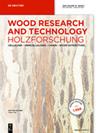α-Fe2O3纳米颗粒对木材抗紫外线降解的保护作用
IF 1.6
3区 农林科学
Q2 FORESTRY
引用次数: 0
摘要
摘要将纳米粒子掺入涂层中以保护木材免受紫外线照射,对提高涂层性能具有巨大潜力。然而,对这些颗粒在木材表面发挥作用的机制的理解仍然有限。研究了α-Fe2O3与木材之间的分布和潜在的化学相互作用。使用紫外线/可见光(UV–vis)光谱评估不同尺寸的Fe2O3颗粒拦截不同波长光的能力,并使用TiO2和ZnO颗粒进行比较。所有粒子都拦截了紫外线,但α-Fe2O3也拦截了一部分可见光谱,这可能有助于解释其更好的性能。扫描电子显微镜/能量色散X射线光谱(SEM-EDS)分析了α-Fe2O3纳米粒子在辐射松(Pinus radiata D.Don)和闪胶(Eucalyptus nitens)不同木材取向上的分布,结果表明,铁粒子均匀分布在松和闪胶上,但对渗透性更强的辐射松表面提供了更好的紫外线防护。通过傅立叶变换红外光谱(FTIR)表征α-Fe2O3与分离的木质素和纤维素之间的化学相互作用,表明这些颗粒与木质素组分之间存在大量相互作用,但与纤维素的相互作用很少。结果表明,纳米粒子在木材表面紫外线防护中的作用是在与木材相互作用时拦截和分散光能。本文章由计算机程序翻译,如有差异,请以英文原文为准。
Role of α-Fe2O3 nano-particles in protecting wood from ultraviolet light degradation
Abstract The incorporation of nano-particles into coatings to protect wood against UV light has tremendous potential for improving coating performance. However, the understanding of the mechanisms by which these particles function on wood surfaces remains limited. The distribution and potential chemical interactions between alpha Fe2O3 and wood were studied. The ability of different sizes of Fe2O3 particles to intercept various wavelengths of light was assessed using ultraviolet/visible (UV–vis) spectroscopy using TiO2 and ZnO particles for comparison. All particles intercepted UV light, but α-Fe2O3 also intercepted a portion of the visible spectrum which might help explain its better performance. Scanning electron microscopy/energy dispersive X-ray spectroscopy (SEM-EDS) analysis of α-Fe2O3 nano-particle distribution on different wood orientations of radiata pine (Pinus radiata D. Don) and shining gum (Eucalyptus nitens) showed that iron particles were uniformly distributed on both pine and shining gum, but provided better UV protection to the more permeable radiata pine surfaces. Characterization of chemical interactions between α-Fe2O3 and isolated lignin and cellulose by Fourier Transform Infrared Spectroscopy (FTIR) suggested substantial interactions between these particles and lignin components, but little interaction with cellulose. The results suggest that the role of nano-particles in the UV protection of wood surface is to intercept and disperse the light energy while interacting with the wood.
求助全文
通过发布文献求助,成功后即可免费获取论文全文。
去求助
来源期刊

Holzforschung
工程技术-材料科学:纸与木材
CiteScore
4.60
自引率
4.20%
发文量
83
审稿时长
3.3 months
期刊介绍:
Holzforschung is an international scholarly journal that publishes cutting-edge research on the biology, chemistry, physics and technology of wood and wood components. High quality papers about biotechnology and tree genetics are also welcome. Rated year after year as one of the top scientific journals in the category of Pulp and Paper (ISI Journal Citation Index), Holzforschung represents innovative, high quality basic and applied research. The German title reflects the journal''s origins in a long scientific tradition, but all articles are published in English to stimulate and promote cooperation between experts all over the world. Ahead-of-print publishing ensures fastest possible knowledge transfer.
 求助内容:
求助内容: 应助结果提醒方式:
应助结果提醒方式:


